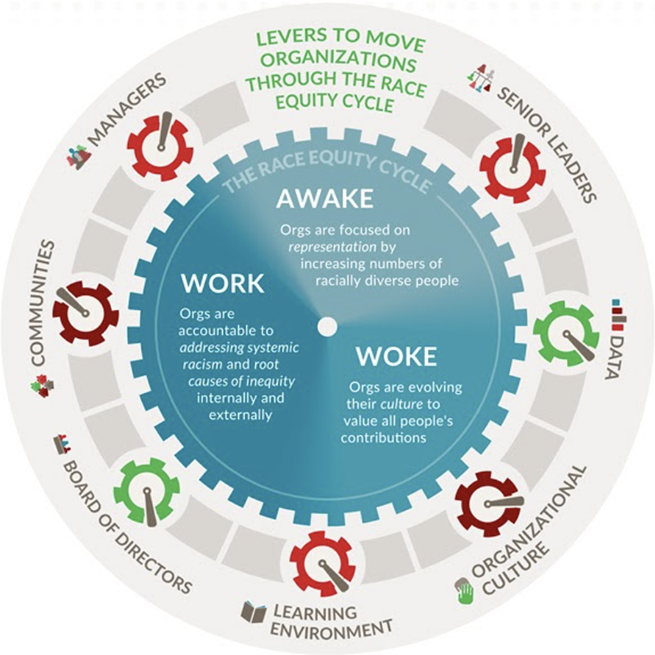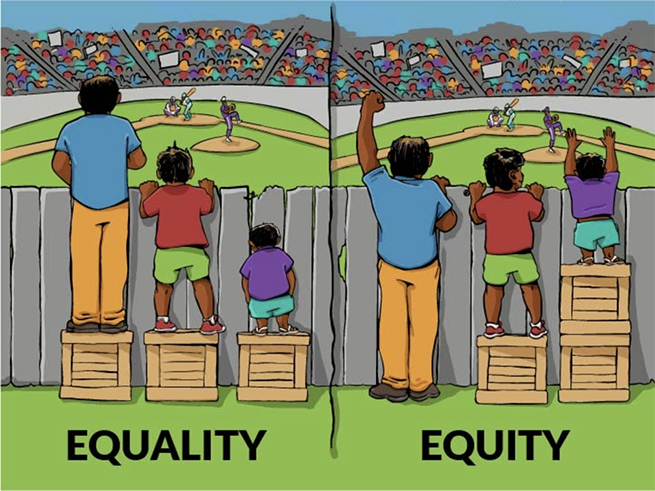Equity and equality are, at times, used interchangeably.
But while these terms have the same underlying themes of fairness and justice, their differences in meaning and implementation can have dramatic impacts for communities facing systemic barriers to realizing full and healthy lives.
Equality means providing the same resources and opportunities for everyone. But equality assumes everyone is starting at the same level to reach the same outcome. The left side of the image above displays the outcome of three individuals given an equal opportunity to watch the baseball game.
Equity, however, recognizes that due to racial or social status some communities need more help than others to achieve the same outcomes. The right side of the same image displays the outcome of the three individuals given an equitable opportunity to watch the baseball game.
Taking an equitable perspective one step further, one may ask ‘why is a fence there at all?’.
Defining Equity
The Merriam-Webster dictionary defines equity as justice according to natural law or right, specifically freedom from bias or favoritism.
The World Health Organization has a more encompassing equity definition: The absence of avoidable or remediable differences among groups of people, whether those groups are defined socially, economically, demographically, or geographically.
Equity in the Center defines equity as: The guarantee of fair treatment, access, opportunity, and advancement while at the same time striving to identify and eliminate barriers that have prevented the full participation of some groups. The principle of equity acknowledges that there are historically underserved and underrepresented populations, and that fairness regarding these unbalanced conditions is needed to assist equality in the provision of effective opportunities to all groups.
Understanding equity at this level reinforces that providing support to underrepresented communities means to foster equity of opportunity to offset the unequal allocation of and access to goods, resources and services.
Equity in the Social Sector
Increasingly, nonprofit organizations are focusing their efforts on supporting marginalized communities to produce equitable outcomes.
According to the Council on Nonprofits, this work means looking inward, too. Social impact organizations need to take a proactive approach in examining internal biases and adopting practices that promote diversity, equity, and inclusion (DEI) in their work, in their employment practices, in their board rooms, and in their communications.
The Council explains that unique perspectives can influence how each nonprofit approaches its mission in more inclusive and innovative ways.
Equity in the Center states all organizations in the social sector go through a cycle of change as they transform from a dominant culture to a Race Equity Culture. These changes include increased representation; a stronger culture of inclusion; and the application of a race equity lens to how organizations and programs operate.
They have coined this process the Race Equity Cycle. This journey of change pushes organizations to become more committed, more knowledgeable, and more skilled in analyzing race, racism, and race equity and in placing these issues at the forefront of organizational and operational strategy.
There are seven strategic levers that organizations can push to help build momentum and success in moving through the Race Equity Cycle, from “Awake” to “Woke” to “Work”.

Advancing Equity
As San Diego’s regional community foundation, one of The San Diego Foundation core values is to strive for an inclusive community where everyone has equitable access to opportunity.
But what does integrating equity into our work look like?
Examples include increasing access to quality early care and education for all working families; enhancing opportunities to obtain college degrees for underrepresented San Diegans; and expanding and leveraging impact investing to promote the equitable flow of capital for social good.
Our Community Scholars Initiative (CSI) is one example of how we’re taking an equitable approach to college access and educational attainment.
Despite their talent and aspirations, first-generation, low-income, and underrepresented students face unique and considerable barriers to achieving a college education. CSI provides financial support and critical wraparound services that bolster academic achievement through need-based scholarships for students, and grants to nonprofit organizations helping students prepare for, pay for and persist in the college environment.
The initiative targets students from underrepresented groups, with a special focus on Latinx youth who make up only 15 percent of our region’s bachelor’s degree-holders despite having some of the highest high school graduation rates in San Diego County.
To date, the Community Scholars Initiative has provided over 270 students $690,000 in scholarships





